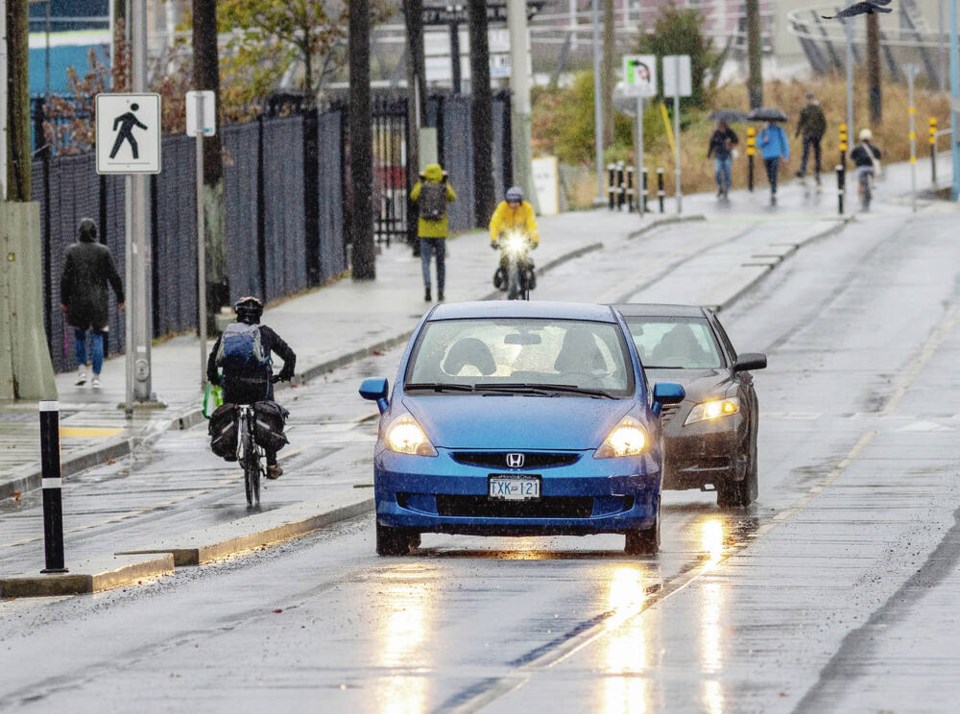We’ve survived the first rainfall of the season. We handled the slippery conditions created by oil, chemicals and dust that accumulated on road surfaces during the recent 10 weeks of drought. The rain washed those materials away.
Where did they go? Into our waterways, of course.
With every rainfall, fish and other critters living downstream of storm drains are exposed to hundreds of pollutants in runoff, including materials and chemicals used in vehicle fluids, tires and paints.
In a study published in March in the journal Environmental Research Letters, University of Toronto researchers found that water samples collected from Toronto-area creeks located next to roads with heavier traffic had higher levels for most of the 35 different contaminants identified — only a small number of the chemicals present in the samples.
Many of the culprits came from oils, lubricants, windshield de-icing fluids, tires, paints, coatings and vehicle furniture. The chemicals dripped or flaked, broke or wore off passing vehicles onto the roads and then were washed into nearby streams by rain.
And recent work out of the University of British Columbia Okanagan suggests that more than 50 tonnes of microplastics from tires and roadways are being released every year into waterways in regions such as the Okanagan.
Based on modelling developed and tested in the Okanagan to examine contamination originating from regular use of vehicles on roads and highways, Okanagan and Kalamalka lakes are being contaminated daily as thousands of people drive the highways connecting communities in B.C.’s Interior.
The synthetic rubber and vulcanized natural rubber used to make tires are polymers that become microplastics when they wear and break down. Other tire particles are composed of filling agents, oils and other additives.
Scientists now know that tire particles are one of the most common microplastic types in aquatic ecosystems. During the lifetime of a vehicle tire, about 30 per cent of its tread erodes and enters the environment.
Each year, with about 1.5 billion tires produced annually to meet global demand for wheels, almost six million tonnes of tire and road-wear particles are generated worldwide.
None of those tire particles is inert. The particles themselves and the chemicals they leach can harm aquatic organisms that encounter them.
In two recent studies, Oregon researchers determined that tire particles and their leachate inhibit growth and caused fish, shrimp and other crustaceans found in freshwater and coastal estuary ecosystems to behave differently.
They also found that although the chemicals leaching from tire particles caused most of the issues in the freshwater critters, exposure to tire particles so small as to be invisible under regular microscopes enhanced the toxicity.
And in March, researchers from the universities of Saskatchewan and Lethbridge found that a chemical added to tires to help preserve them is deadly to rainbow and brook trout. The work builds on an earlier study by Washington state researchers that found that 6PPD-quinone is responsible for killing 50 to 100 per cent of spawning coho in Puget Sound’s urban streams.
6PPD is added to tire rubber to keep it from breaking down quickly. The chemical protects tires from ozone, a highly reactive molecule created when vehicle and other chemical emissions react in sunlight. Ozone busts the molecular bonds holding tire rubber together, and 6PPD protects tires by binding with ozone before it can react with the tire rubber, thereby sparing the tires.
However, as tire treads wear down, pieces flake off and small rubber particles scatter across roads. There, they react with ozone, which converts helpful 6PPD to nasty 6PPD-quinone, which kills coho and trout when it washes into waterways.
These contaminants won’t disappear once we all trade up our gas- and diesel-burning cars and trucks for electric models. Although some contaminants from vehicles do originate from burning fossil fuels, even battery-run vehicles still need to be painted and use winter-friendly windshield-washing fluid in frosty months. They also still require tires.
Some of the contaminants can be controlled only at larger scales by regulatory agencies and governments. Regular street cleaning can help by collecting tire and road dust before it flushes down storm drains and into our waterways.
And, as individuals, we can help save the fishes and our drinking water by fixing oil and fluid leaks, addressing flaking paint, and keeping our vehicles maintained.
keiran_monique@rocketmail.com
>>> To comment on this article, write a letter to the editor: letters@timescolonist.com



